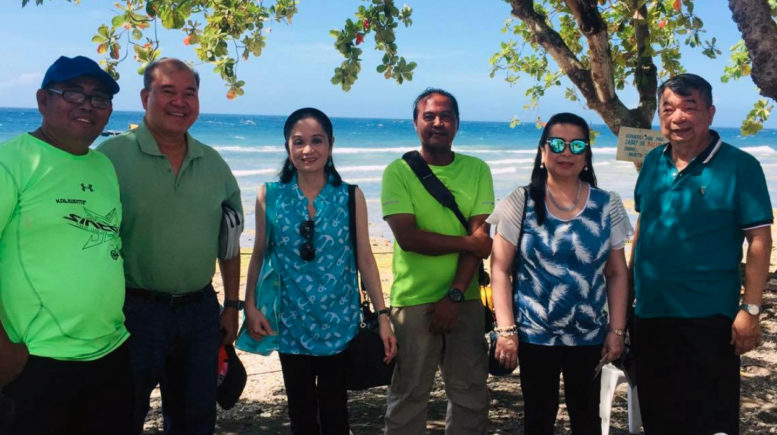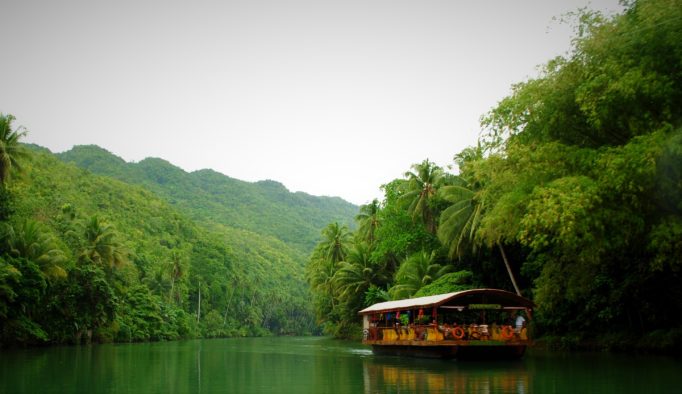A visit to the Visayas is never complete unless you take a ferry ride from Cebu to Bohol. Upon arrival in Bohol, one is immediately enchanted by the blue sea and clear skies over the horizon. It’s rare to see these colors in a city jungle where the air is full of smog and emissions.
First stop in beautiful Bohol would be a visit to Villa Aurora, Bilar, Bohol to catch a glimpse of the little Tarsier. Perched on a tree branch, a Tarsier is hardly visible because it is so small and its skin color is that of a tree branch. You can only spot them through their extremely large, and light brown eyes. Have fresh buko (coconut) juice right at the patio of the Tarsier Sanctuary.
Second stop would be to visit the majestic Chocolate Hills covered with a forest of mahogany trees. Hike up to the Grotto of Mama Mary and make a wish.
Last but definitely not the least would be to embark on a Loboc River Cruise. Cruising down Loboc River on a man-made raft would make you appreciate the lush greenery of the Loboc Forest, still pristine and untouched by urbanization.
Loboc River is also called Loay River. While cruising along the Loboc River, you will get to view a series of mini waterfalls cascading from the side. Sumptuous Filipino food is carefully prepared and spread out on a long rectangular table for a self-service buffet lunch while cruising. It’s like a floating restaurant. There is an accompaniment of Filipino songs serenaded to guests by the Bohol children’s choir onboard a nearby raft, where there is also a performance of the Tinikling, which is one of the famous national dances of the Filipinos. Boholano hospitality will never cease to delight you.
According to Filipino historian Fr. Horacio de la Costa regarding the Municipality of Loboc, “Bohol was founded by Fr. Juan de Torres in 1602.” Fr. Horacio de la Costa further elaborated, “The village of Loboc was established and became a parish in 1602. It became the “Residencia Boholano” or the place where the local superior of the Jesuits lived. From that time until the middle of the 18th century, Loboc played host to the “Residencia,” then they moved back to Baclayon (the first municipality the Spaniards established in the island). The first stone church of Loboc was built then.”
According to the Museo de Loboc, the name ‘Loboc’ came from the local dialect ‘Ga Loboc’ meaning ‘pounding palay.’ When the Jesuit missionaries arrived at the village, they passed by a family pounding rice. They asked for the name of the place. Thinking that the natives were being asked what they were doing, the head of the family answered, “ga Loboc.” The name stuck, and to this day, the place, and eventually the town, is known as Loboc.
While in Bohol, one should also visit the historical Baclayon Church (La Purisima Concepcion de la Virgin Maria Parish Church also known as The Immaculate Conception of the Virgin Mary Parish Church), and then visit the Blood Compact Monument memorializing the blood compact between Miguel Lopez de Legazpi of Spain and Datu Sikatuna, Chief of Bohol.
There is also dolphin watching as well as whaleshark (Butanding) watching along the coast of Lila, southern Bohol. It appears that the sea along the coastal town of Lila is the nursery bed of the whalesharks (Rhincodon). The townsfolk believe that the whalesharks choose the Lila coast as their birthing area because Bohol takes care and protects its natural marine resources. If you are a diver, you will also appreciate the live colorful corals, large marine turtles (Pawikan), giant clams (Tridacna), and the large conch shells (Budyong) formerly used as a sound alarm or trumpet before the Spaniards arrived in Bohol.
All these Boholano activities can be accomplished in a day’s time if you start the day early. Rest and relaxation, with a breath of fresh unpolluted sea wind and river air are what tourists visiting Bohol can truly benefit from all day. I’m so glad to have visited Bohol.
References:
-
Horacio de la Costa - Municipality of Loboc
-
Museo de Loboc

